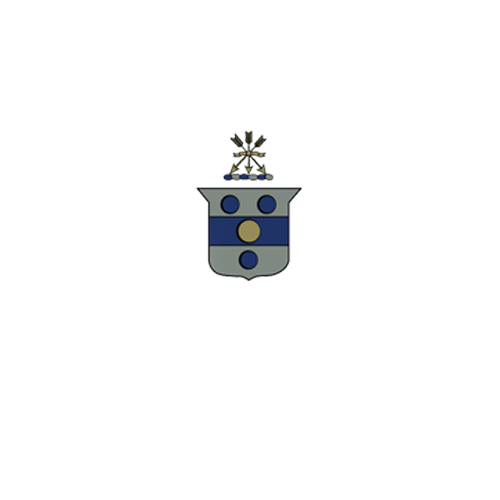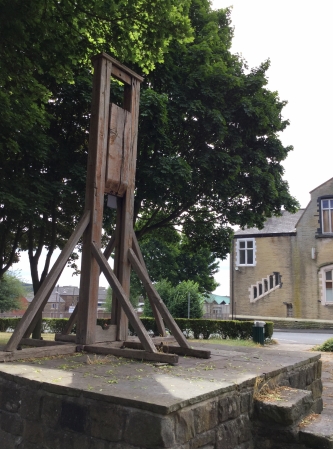The Gibbet at Halifax, England, an icon for Fairbanks and Prescotts in the 1600's
The Guillotine of Halifax Parish, West Riding, Yorkshire, England
1289 -1650
Gibbet or Guillotine of Halifax, West Yorkshire, England
Between 1541 and 1650, when official records were kept, fifty-three people (men and women) were executed (beheaded) by the Halifax Gibbet. Every citizen of Halifax Parish of Yorkshire, England, knew the reference to the executions in this phrase: “From Hull, Hell, and Halifax, Good Lord deliver us.” Dutiful fathers, like Jonathan Fairbanks and John Prescott, used these words to caution their sons to follow the rules.
The Gibbet of Halifax enforced the 7th Commandment of God, ‘Thou shall not steal.’ Its swift accurate stroke was thought to be less cruel than an ax.
The simple heavy wood structure was raised on a stone platform, reached by a flight of steps. A movable wooden block supported an iron ax blade. It was held aloft by a pin attached to a rope. When released, the block ran in the side channels to its target. The block was so heavy that the blade was never sharpened, yet decapitation was always complete.
The Thieves Litany tells the facts very concisely:
“At Halifax, the Law so sharpe doth deale,
That whoso more than thirteen pence doth steals,
They have a jyn [engine] that wondrous quicke and well
Sends Thieves all headless unto Heav’n or Hell”.
http://www.calderdale-online.org/community/life/life12.html
A lustful person had many opportunities to steal cloth prepared for market. Wet woolen cloth was stretched on tenters, wooden frames, in the clothiers front yards. The cloth was left out over-night to dry naturally.
If you think beheading was an unjust punishment, it was not taken lightly then. A jury of sixteen local men, probably the wealthiest and most reputable, tried the case. Four were chosen from each of four local townships. The court was held at the bailiff’s house. The plaintiff and defendant presented their cases.
If the thief was caught ‘red handed’ (caught with stolen goods in his hand or in the act of stealing), ‘backbent’ (caught carrying stolen goods on his back), or ‘tongue confessing’ (having confessed to the crime), and the goods were worth more than 13 1/2 pence, he/she was found guilty. The execution was carried out the next market day.
On the market day, a bagpiper played the traditional dirge as the crowd gathered for the spectacle. Miles around, people heard the familiar chilling sound. The Gibbet with blade held high by a pin, waited ominously. The sixteen local jurors stood nearby and watched as the Gibbet delivered its justice. Under their breath, all repeated the Thieves Litany, ‘From Hell, Hull and Halifax, Good Lord deliver us’
Sadly, there were two Fairbanks, George and his daughter Anna (relationship to our family unknown), who lost their heads to the Halifax Gibbet on December 23, 1623. This was prior to our family’s departure to New England. They might have witnessed the execution.
The Gibbet was not flawless. If the block jammed in the channels and the thief was able to escape across Hebble Brook into the next county, he/she would not be pursued. If the thief returned to Halifax parish later, he/she was executed. Only two such cases are recorded in history. https://www.kidzworld.com/article/456-history-the-halifax-gibbet
‘From Hell, Hull, and Halifax, Good Lord deliver us’
References:
https://www.atlasobscura.com/places/the-halifax-gibbet-halifax-england
http://www.calderdale-online.org/community/life/life12.html
https://en.m.wikipedia.org/wiki/Halifax_Gibbet
http://www.calderdalecompanion.co.uk/f.html
https://www.kidzworld.com/article/456-history-the-halifax-gibbet
Daniel Defoe, A Tour Thro’ The Whole Island of Great Britain, Divided Into Circuits or Journeys (London: JM Dent and Company, 1927)
http://www.guillotine.dk/Pages/gibbet.html
https://theyorkshirejournal.files.wordpress.com/2018/11/2018-2-the-halifax-gibbet-pages-26-45.pdf








